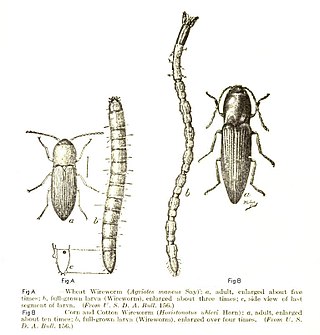
Elateridae or click beetles are a family of beetles. Other names include elaters, snapping beetles, spring beetles or skipjacks. This family was defined by William Elford Leach (1790–1836) in 1815. They are a cosmopolitan beetle family characterized by the unusual click mechanism they possess. There are a few other families of Elateroidea in which a few members have the same mechanism, but most elaterid subfamilies can click. A spine on the prosternum can be snapped into a corresponding notch on the mesosternum, producing a violent "click" that can bounce the beetle into the air. Clicking is mainly used to avoid predation, although it is also useful when the beetle is on its back and needs to right itself. There are about 9300 known species worldwide, and 965 valid species in North America.

Chauliognathus is a genus of soldier beetles in the family Cantharidae. Adults have almost rectangular bodies. Some are red and black, similar to the military uniforms that were common before the usage of camouflage, hence the name of soldier beetles. Others are orange and black. The elytra or first pair of wings are softer than the elytra of most beetles, that is why their other common name is leatherwings. The adults are frequently found on flowers, such as sunflowers, goldenrod, coneflowers, where they mate and feed on pollen and nectar. The larvae are more common in the ground or among debris, where they feed on eggs or larvae of other insects. The adults are most frequently found in summer and early fall. They are native to America and Australia.

Chalcolepidius is a genus of beetles in the family Elateridae.

Lanelater is a genus of click beetle belonging to the family Elateridae.
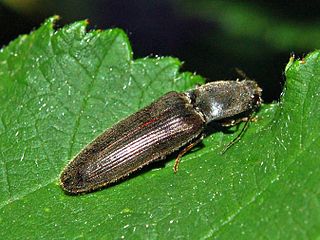
Athous is a genus of click beetles belonging to the family Elateridae.

Hemicrepidius is a genus of click beetle belonging to the family Elateridae.
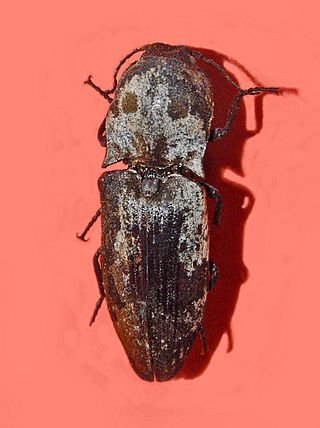
Calais is a genus of click beetle belonging to the family Elateridae and the subfamily Agrypninae.
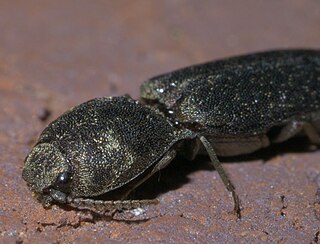
Lacon is a genus of click beetle belonging to the family Elateridae and the subfamily Agrypninae.
Cardiorhinus is a genus of click beetles in the subfamily Elaterinae.

Limonius is a genus of click beetles in the family Elateridae. Many of the species formerly placed in this genus have been removed to other genera such as Gambrinus.
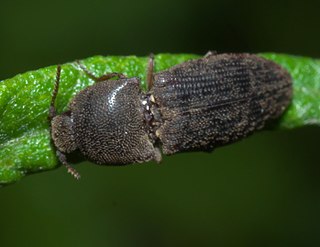
Agrypnini is a tribe of click beetles in the family Elateridae.

Agrypninae is a subfamily of click beetles in the family Elateridae.

Megapenthes is a genus of click beetles in the family Elateridae. There are at least 30 described species in Megapenthes.
The Oophorini form an accepted taxonomic tribe within the Elateridae subfamily Agrypninae.

Ampedus is a genus of click beetles in the family Elateridae. There are currently 461 recognized species of Ampedus beetles. It has a cosmopolitan distribution, but is found mostly in the Holarctic region, primarily in North America, Europe, and Asia. The oldest known fossil from this genus was found in Eocene Baltic amber, estimated to be from 38.0 to 33.9 million years ago.
Gambrinus is a genus of click beetles in the family Elateridae, most of which were formerly included in the genus Limonius.
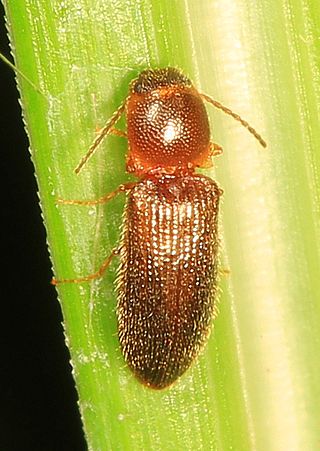
Tetralimonius is a genus of click beetles in the family Elateridae, formerly included in the genus Limonius.

Anchastus is a genus of beetles belonging to the family Elateridae. The species of this genus are found in America, Southern Africa, Australia.

Dipropus is a genus of click beetles in the family Elateridae. There are around 150 described species in Dipropus, found in North, Central, and South America.
















